Journalist delivers ninth annual Roosevelt lecture
This past Thursday, Isabel Wilkerson, the first African-American woman to win the Pulitzer Prize in Journalism, spoke at the ninth annual Eleanor Roosevelt Lecture.
Wilkerson is most well known for her bestseller, The Warmth of Other Suns. She spent over 15 years writing this tale of the great migration of African-Americans from the southern United States and their relocation to the north and west of the country. Wilkerson mentioned drawing inspiration for this book from the plight of her own parents. Several times throughout the lecture, she raised the point that had this migration not have happened, she would not exist.
The program was kicked off by Prof. Susan Lanser (ENG), chair of the Women's and Gender Studies Program. Prof. Jane Kamensky (HIST), Harry S. Truman Professor of American Civilization, introduced Wilkerson.
The Warmth of Other Suns follows the lives of three people on their journey from the South to their new homes in other sectors of the country. The first is Ida Mae Gladney, a sharecropper who left Mississippi for a new life in Chicago. There, she got to understand the process of voting for the first time, and in her later life voted for Barack Obama as Illinois senator.
Wilkerson next chronicles the life of George Starling, a man who left his life in Florida for a new start in Harlem. In Harlem he fought for civil rights and found solace in religion. Finally, she writes about Robert Foster, a physician who left Louisiana for California. In his fresh start, Foster became the physician for Ray Charles.
After introducing her book, and reading the audience a passage, Wilkerson led a question-and-answer session. Among the audience asking questions was a grandchild of the migration. Wilkerson continued answering questions about famous children of the migration and about her commitment to telling this tale. One of the audience members questioned Wilkerson on how she chose the format for the book. "I knew there were going to be three characters, because there are three major streams of migration. The one up the East Coast, ... the Midwest stream ... and then there was the West Coast stream. So that was the essential choice made for me by the structure of the migration. I also wanted to show and not tell that [the migration] went on for a very long time. Rather than me telling you that it went on for a long time, I wanted to show you that it went on for a long time, that means that I had one of three people who had left in three different decades."
According to BrandeisNOW, this lecture series was "created in 2004 to honor Roosevelt's commitment to social justice and her important place in women's history." The series is hosted each year by the WGS program. The cosponsors for the this specific event, which was held in Rappaporte Treasure Hall, were the American and Afro-American Studies Department, the History Department, the Mandel Center for Humanities and the Schuster Institute for Investigative Journalism.
After the event, Susannah Feinstein '14 spoke with the Justice about her reactions to the event. "I thought that the event was amazing and I wish that more students had been there. ... She is an incredibly talented storyteller who spoke eloquently about the significance of this journey."
Feinstein read Wilkerson's book this past summer and said that when she heard Wilkerson was coming, it was an event that she did not want to miss. Prof. Chad Williams, chair of AAAS, was also in attendance at the event. Williams, whose studies specialize in studying African-American history around WWI, which happened to be the start of the great migration, discussed how Wilkerson's lecture captured the spirit of the book and how the title reflects the truly epic nature of the migration.
Feinstein finished up her comments by mentioning how important historical books such as these are because "history teaches us where we came from, where we are going and how to get there."



Please note All comments are eligible for publication in The Justice.